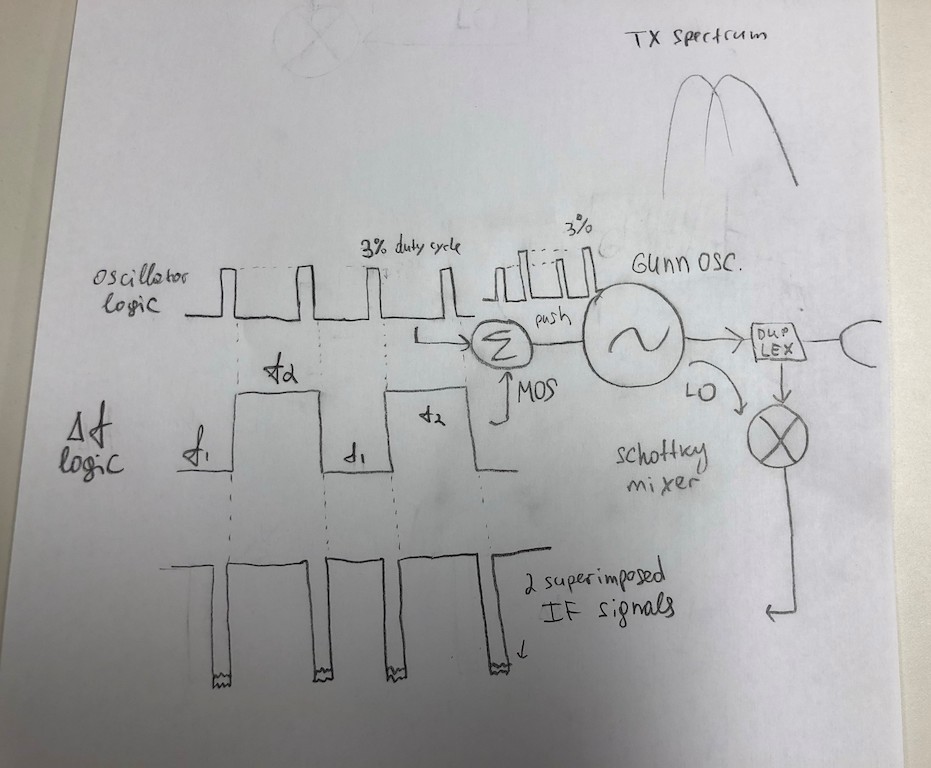Modulation scheme of this pulsed/two-frequency radar system

https://imgur.com/aW3aDLV
I'm trying to figure out how does this radar system works. Transmit Gunn diode is driven by mixing oscillator logic 3% duty cycle pulse with delta f logic, triggered on the falling edge of oscillator logic by a circuit with two MOSFETs, several resistors and one MOSFET driver to push/pull Gunn diode. If I'm not mistaken, when the two mixed, output to Gunn oscillator should have have slightly different amplitude for pull/push. Transmitted spectrum looks like two frequency pulses close to each other. This part is more or less clear to me. What I don't understand is when I measure output of mixer, there are two IF signals (due to f1 and f2) of slightly different magnitude but they are superimposed. I don't understand why aren't there two separate signals. Are f1 and f2 triggered at the same time?
I need to figure out how this is set up and duplicate modulation scheme on BGT24LTR11 mmic so I don't really want to learn nuances of Gunn and Schottky diodes, I just need to understand how it's done.
I have several radar textbooks by Skolnik, etc but I couldn't find examples of similar modulation schemes with two IF signals sitting on top of each other.
Many thanks
I'm not certain and I confess I have never seen this method used but I would guess it somehow uses the two frequencies to differentiate between objects arriving or leaving the beam path. With continuous carrier, the Gunn device produces a single frequency and the detector sees that frequency mixed with the reflected signal to produce a steady output. In theory, with no motion present the mixer output is DC (only residual mixer current from the outgoing RF) and changes in reflected frequency caused by Doppler shift modulate the current producing a mixer product proportional to the rate of change in distance.
What it can't easily tell is whether the shift is caused by an increase in frequency because the reflection comes from an approaching object or a decrease if it moves further away. The (Fosc - Fref) and (Fosc + Fref) result in the same output as it only produces the difference between them. My guess is that by altering the Gunn voltage, and hence the oscillator frequency, it somehow works out the direction as well as speed. The critical point being that the Gunn frequency changes as the voltage across it is altered.
Brian.
I don't know - taking a stab in the dark
are your 2 frequencies low level signals presented to the transmitter,
or are they a transmitted frequency and a reflected frequency, as betwixt describes, which look like a Doppler radar
the return frequency goes up if the object is approaching and goes down if the object is receding
if they are low level signals presented to the transmitter, it may be a minimum shift keying modulations scheme
i worked at a place that used MSK to transmit binary (not a radar system)
MSK is like a frequency shift system, but the phase is maintained when you change frequency
it may help if you provide the circuit diagram of the fets and diode, the duplexer and the mixer
I think, without some quantitative information, e.g. carrier frequencies, pulse width, transmitter rise time and receiver time resolution, it's impossible to guess about the purpose and measurement performance of combined ASK/FSK modulation.
Apologies for this thread, I have triggered oscilloscope to output, not delta f so there were two waves on top of each other. There's just one downconverted signal, all is explained.
